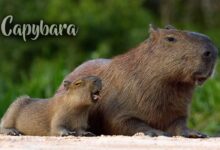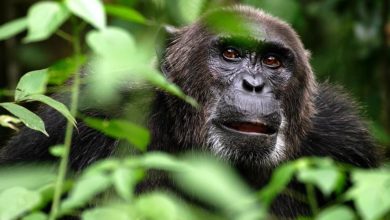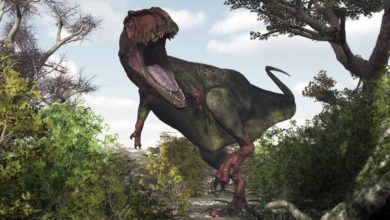Emu – flightless birds
The emu (Dromaiidae)
The emu belongs to a family of flightless birds and is one of the largest birds in the world, alongside the African ostrich and the cassowary. There is only one living representative of this family today – the emu (Dromaius novaehollandiae). It inhabits Australia, where it is nearly as common as chickens are in Europe and America. The emu is fast, enormous, and sometimes dangerous. This bird has perfectly adapted to a walking lifestyle
Although it is commonly called the emu, it belongs to the cassowary order (Casuariiformes) and it is not the ostrich.

Classification:
- Kingdom: Animalia
- Class: Aves
- Order: Casuariiformes
- Family: Dromaiidae
- Genus: Dromaius
- Species: Dromaius novaehollandiae
There are three species of the Dromaius genius:
- Emu (Dromaius novaehollandiae) + five subspecies
- King Island emu / the black emu (†Dromaius ater / Dromaius novaehollandiae ater) – extinct
- Kangaroo Island emu / the Dwarf emu (†Dromaius baudinianus/ Dromaius novaehollandiae baudinianus) – extinct.

Distribution
The emu is a bird that primarily inhabits the Australian continent, avoiding densely populated areas, dense forests, and arid regions (except during the rainy season). It mainly resides in Australian scrublands, also known as “the scrub,” or in so-called sclerophyll forests (which are similar to scrublands).
In Western Australia, seasonal movement patterns have been observed in emus: they tend to stay in the north during the summer and migrate south during the winter. Such migrations have not been noted on the east coast. It is estimated that the total population of these flightless birds across the continent ranges from 625,000 to 725,000, with approximately 100,000 to 200,000 in Western Australia. The remaining population is largely found in Queensland and New South Wales.

Appearance and behavior – characteristics
Females are slightly bigger than males, they are also a bit wider in the rump. The emu has vestigial wings of about 20 cm (8 in) long. Emus flap their wings when they move around. It is thought that this is the form of the stabilizer, thanks to which the animal does not fall down. The bill is small (around 5-6 cm [2-2.3 in] long) and delicate – adjusted to grazing in the soft ground. The neck and legs are very long. The emu’s feet have three toes with claws at the end. Legs have no feathers and there are thick cushioned pads underneath its feet.
The neck is pale blue. Shaggy feathers are dingy brown. Feathers are black at the end. Sunbeams are absorbed by the feathers’ tips and their internal layer. Thanks to this, the skin is insulated and the emu can be active even during hot days. The internal layer of feathers is similar to the fur and the external part is a little bit hairy. The plumage changes its color under the influence of the environment so as the bird can be better camouflaged – in wet conditions, species are darker.
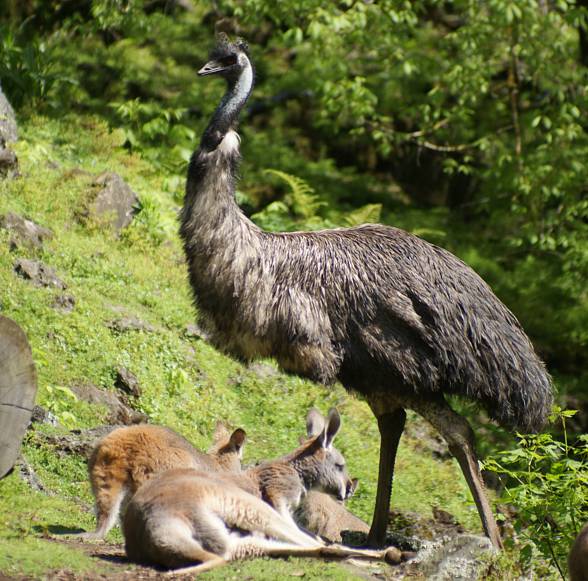
Emus also have sharp claws on their legs just as cassowaries. They serve as the sword and the shield at the same time. They are used in defense kicking the opponent. The total length of the toe and the claw is about 15 cm (6 in).
The emu has perfect sight and hearing; thanks to them, it can spot the danger really quickly. It has one of the strongest legs in the animal kingdom.
Emu’s eyes are protected by the membrane which protects the orb from dust or sand. What is more, it also has the tracheal pouch, which is prominent while the mating season. It is supposed that the pouch is used for general communication. Its size is estimated at over 30 cm (12 in) – it is wide but has thin walls. It opens at a width of around 8 cm (3 in). Thanks to it, the female emits louder sounds than the male, although both genders have this pouch.

During hot days, emu gasps in order to maintain the constant body temperature.
Emu’s exhortation is very loud – it can be heard from a distance of 2 km (1.2 mi). Vocalizations consist of buzzing, grunting and rumbling. Every gender has its own sounds. Loud grunting is characteristic of the male.
Emu sleeps at night and it prepares for sleeping at the sunset but it does not sleep all night nonstop. It can wake up even eight times per day in order to eat or defecate. Before sleeping, the emu kneels down and falls asleep. The neck is closer to its body and eyelids close down. The body touches the ground and the legs are folded. Feathers go down. This sleeping position also serves as camouflage. The emu wakes up really quickly under the influence of the sound or the movement.

Diet
The emu’s diet depends on the season. It eats many local and introduced types of plants and what is more, it eats insects (grasshoppers, crickets, ladybirds, moth larvas, ants, caterpillars). In Western Australia, emu eats seeds of mulga (Acacia aneura) while traveling. After the rainfall, it eats fresh grass shoots and caterpillars. In winter, it prefers dry leaves.
It also likes eating the fruits of santalum (Santalum acuminatum). The cultivation of wheat, as well as available fruit and plants are also good for the bird. The emu is able to climb onto the high fence in order to get its favorite treat. After consuming fruit, its seeds are excreted, which is good for sowing important plants in the area of Australia.

The emu must consume small and medium stones to help itself to digest plants. At the same time, the stomach can hold around 140 g (5 oz) of pebbles. Apart from that, the emu eats the charcoal but nobody knows why. It happens that these flightless birds swallow the shards of glass, marble, car keys, bolt nuts, and jewelry.
The emu rarely drinks but it can drink a huge amount of water at once. It usually drinks once a day although it can drink more if it needs to. It prefers drinking solely without the presence of other animals. It usually drinks kneeling down but when it feels in danger, it drinks standing.
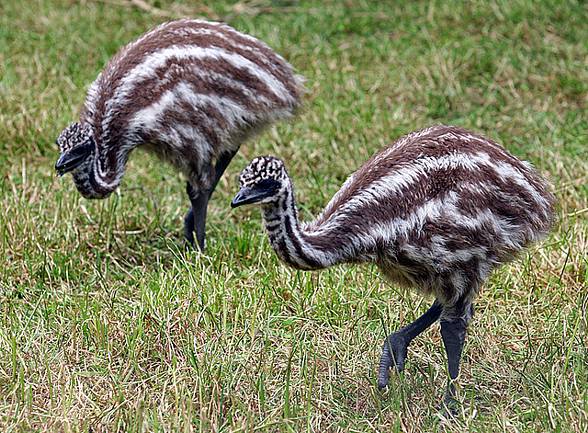
Reproduction
The couples mate in December and January. They can stay together even up to 5 months. At that time, they travel an area of a few square kilometers. They probably look for a good place to lay eggs. The male and the female become heavier during mating but they lose weight during incubating eggs. The mating takes place in cooler months (May – June). The exact time depends on the climate.
The Female’s bill becomes turquoise-blue and its feathers become darker.
The female strolls around the male ruffling feathers and giving out deep monosyllabic sounds similar to drum beats. This sound is used when the lonesome male, which it has an eye on, stands further than 50 m (164 ft) away. When the female gets the male’s attention, it approaches the male to the distance of 10-40 m (33-131 ft) turning its neck and keeping its rump towards the male. The passive male does not change the color of its plumage but it has blue marks on the skin. These are very subtle changes and somebody who is not a scientist would find it difficult to distinguish the gender.
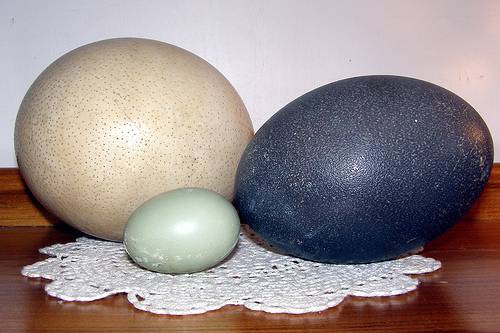
If the male is still interested, the female approaches it gradually flaunting. Females often fight with each other to obtain the male. Females’ fights represent 50% of all violent acts while mating. When the female becomes interested in the taken male, its partner does everything to discourage the rival. Fights between females can last up to 5 hours during which they chase and kick each other.
When the copulation happens, partners rub each other. Next, the female dips showing its rump.
The female lays eggs every 2-3 days. It approximately lays from 1 to 11 eggs (sometimes even 20) which are very big and dark green. One egg weighs from 700 to 900 g (30 to 32 oz) and it is from 89 to 134 mm (3.5 to 5 in) long.

The male takes care of eggs. During all incubation period (around 8 weeks), it does not eat, drink and defecate. It takes care of eggs and rotates them around 10 times a day. It sometimes walks away from them at night. Females are not faithful and therefore, the male can bring up the young which are not its own.
The incubation lasts around 52 days. During the incubation, germs are ectothermic but they must develop endothermic behaviors while hatching out. Young chicks are active and can leave the nest within a few days. They are around 12 cm (5 in) high and weigh about 0.5 kg (1.1 lbs). They have striped plumage, which is in the shades of brown, and beige but it will change after around 3 months. The father takes care of the young for about 7 months teaching them how to get food. Young emus are completely developed at the age of 5-6 months old.

Emu (Dromaius novaehollandiae)
The emu lives on the whole Australian continent. This species of the emu has brown fluffy feathers reaching up to 2 m (6.6 ft) high maximum. It has a long thin neck and legs. It can travel long distances trotting. It can reach a speed of 50km/h (31 mph). Its length of the step is up to 275 cm (9 ft). It can travel long distances foraging and it mainly eats plants, insects. It can also swim and it likes observing other animals and people. It is the only living species from Dromaius genus. It is not endangered.

King Island emu / Black emu (Dromaius ater/ Dromaius novaehollandiae ater)
This extinct endemic species of the emu lived on the King Island, which is situated in the Bass Strait between Australia and Tasmania. Its small size is an example of insular dwarfism (island species coming from the land species are smaller than their relatives constantly staying on the land are).
It was the smallest species of the emu (its size was around 50% of the land emu’s size). It had black and brown plumage also on its blue neck and head. Its feet and bill were very dark.
The black emu was discovered by Europeans in 1802 during the first excursions to the King Island. Hunting and the fire caused by the first settlers resulted in the destruction of these small flightless birds in 1805. Two specimens, which are considered the last representatives of species, died in captivity in Paris in 1822.

Kangaroo Island emu / Dwarf emu (Dromaius baudinianus / Dromaius novaehollandiae baudinianus)
At present, it is extinct. It lived on Kangaroo Island and South Australia. It is thought that it lived deep inside the forest contrary to the emu, which avoided such areas. Its lifestyle was not well-known. It is sure they lived in the forest out of human’s reach and in the evening, they appeared on the coast. It had a similar size to the black emu. The information about this species was gained from watchers and from found bones, which have been stored in South Australia Museum in Adelaide until now.
It is estimated that the dwarf emu became endangered in 1827 because of forest fires and hunting.
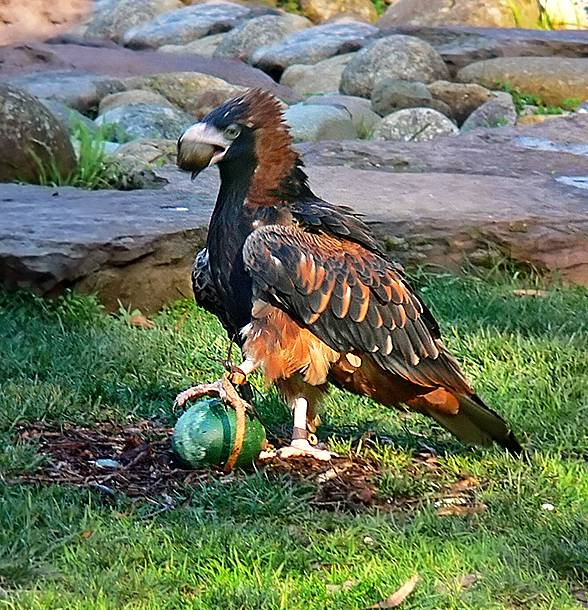
Detailed information / size
The emu (Dromaius novaehollandiae)
- Height:
- 150-190 cm (59-75 in) – to the top of the head
- 100-130 cm (39-51 in) – the height at shoulders
- Length from the bill to the tail: 139-164 cm (55-65 in), males are usually up to 149 cm (58 in) long and females up to 156 cm (61 in)
- Weight: 18-60 kg (40-132 lbs); males average weight – 31 kg (68 lbs), females average weight 36.9 kg (81.4 lbs)
- Toe with the claw: 15 cm (6 in)
- The length of the step: while walking – up to 100 cm (3ft 3in); while running- up to 275 cm (9 ft)
- Lifetime: 10-20 years
The black emu (Dromaius ater / Dromaius novaehollandiae ater)
- Height: around 87 cm (34 in), the record specimen was 137 cm 4.5 ft)
- Weight: 20-23 kg (44-51 lbs)

Emu – interesting facts
- The walking emu takes steps of 100 cm (39 inches) in length. While running, these steps can extend up to 275 cm (9 feet).
- The emu can reach a speed of 50 km/h (31 mph).
- Thanks to its strong legs, it can destroy a fence made of metal wire.
- The emu sleeps for around 7 hours a day.
- The emu is very cautious around other animals. It hides in the bushes until the stranger moves away.
- During mating season, females are far more aggressive than males.
- The male, while caring for the eggs, loses around 1/3 of its body weight.



